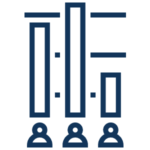Development Actions Form
What is Talent Development?
Talent development is the process of developing individual employees’ skills and abilities, as well as nurturing (building and maintaining) the organization’s overall talent pool. From recruiting and onboarding to succession planning, talent development is the engine that drives nearly every human resource (HR) process.
Plan and Track Individual Talent Development
Talent development is the most time-consuming stage in SIGMA’s six-step succession planning process, but it is also the most important. To help leaders do this well, SIGMA has created the Development Actions Form. The Development Actions Form is a template that can be used with employees to plan and track their individual talent development. The purpose of this worksheet is to clearly identify areas for development and track progress toward goal attainment over time.

Why Use the Development Actions Form?
There are many benefits to establishing a robust talent development process – both for employees and the organization. The Development Actions Form is an important tool because it allows organizations to standardize their talent development efforts. This Form provides a ready-made, easy-to-use template that organizations can use to guide their talent development efforts. In particular, the Development Actions Form can help organizations to:
- Standardize and scale the talent development process. When talent development processes are standardized, they are much easier to replicate and therefore scale across different teams, departments, and organizations.
- Create detailed development plans. The Development Actions Form helps individuals set SMART goals. It challenges candidates to move beyond vague intentions to clearly list a variety of short-, medium-, and long-term goals.
- Provide feedback. The Development Actions Form includes space to track progress. This can help candidates identify their own movement towards goals, and it can also help leaders provide feedback and evaluate performance.
Research suggests that structured and evaluated individual development is more likely to result in lasting behavior change.[1, 2] From an organizational perspective, measuring and monitoring employee efforts over time also makes it more likely that concrete objectives will be attained.[3] The Development Actions Form allows human resource practitioners, coaches, managers, and leaders to localize and organize their development process, making it more likely that goals will be achieved.
Benefits of Using the Development Actions Form
The Development Actions Form is a critical tool for succession planning. It shows how to transition employees from being potential candidates to viable successors using a structured development plan. Apart from supporting the succession planning process, the Development Actions Form can also help organizations to:
- Set effective short-, medium-, and long-term goals.
- Maintain accountability towards goals over time.
- Help employees track and observe their own progress.
- Help leaders evaluate their employees’ progress.
- Help organizations understand what types of talent development opportunities their employees are seeking.
How to Use the Development Actions Form
Although succession candidates should take responsibility for their own development, the Develop Talent stage of an organization’s succession plan is best managed with the help of a trusted leader or coach. At SIGMA, we recommend providing support to candidates as they complete the form and making this a key part of one-on-one discussions about the candidate’s development needs and priorities. Once the Development Actions Form has been completed and the plan is ready to be implemented, we recommend holding further coaching meetings to monitor progress.
Before completing the Development Actions Form, make sure Success Profiles have been created for the role in question. We recommend using the Candidate Profile to identify candidate skill gaps first. We will refer back to these skill gaps when selecting top development areas and brainstorming development actions on the Development Actions Form.
Ready to get started? Follow the steps below to create an individual talent development plan for a succession candidate using the Development Actions Form.

Begin by listing the succession position that the individual is a candidate for, as well as the name of the candidate in question and their current position.

Indicate the top opportunities for personal development for this candidate. These opportunities for development should be informed by the gaps identified in the Candidate Succession Profile worksheet as well as the candidate’s personal motivation.

From the list of top development opportunities, select which ones will be focused on in the next 3-6, 6-12, and 12+ months.

For each development area, list a task, experience, or other activity that will be used to develop the skill. Think of job shadowing opportunities, cross-departmental tasks, stretch assignments, and more. For each activity, specify the timeframe within which it is to be completed.

Use the notes section at the bottom of the form to record any extra information that might be relevant to the candidate’s development.
Talent Development Strategies to Consider When Using the Development Actions Form
Using validated assessments to measure a candidate’s performance, potential, character, emotional intelligence, and other traits provides you the data you need to create development plans that address the gaps between a candidate’s current capabilities and where they need to be in the future. The development stage is where you execute a plan to fill in those gaps and monitor progress over time.
Here are some key talent management strategies to consider when preparing development plans:
Prepare Plans for High-Potential Candidates
At a minimum, we recommend creating a development plan (i.e., filling out a Development Actions Form) for each of your high-potential succession candidates. Ideally, you should have development plans in place for your entire Succession Bench; however, high-potentials are an excellent place to start.
Customize the Plan to Individual Needs
There are many methods (and combinations of methods) to fill development gaps, such as one-on-one executive coaching, stretch assignments, mentoring and so on. Select methods that best suit both the role and the individual. To access practical ideas for on-the-job talent development, explore SIGMA’s competency development guides.
Include Measurable Deliverables
Incorporate deliverables in each development plan that are measurable to ensure accountability. These metrics should be assessed every six months to ensure appropriate progress is being made.
Consider a Range of Learning Modalities and Contexts
While filling out the Development Actions Form, be sure to consider a range of development activities across a variety of contexts. Succession candidates will be more well-rounded and accomplished if their training includes self-development, support from other leaders, cross-functional experience, and international project involvement. Note: It may be necessary to look beyond a succession candidate’s department, or even outside of the organization, to provide such diverse talent development opportunities. Keep track of which development activities are completed, as well as those that are recommended for future growth.
Give Candidates Time and Support
Ensure that succession candidates get the appropriate assistance and time to make progress in their skills. This will require backing from the individual’s leader (who often is the incumbent currently in the position).
Review Plans Regularly
Take time to review each development plan regularly and, at minimum, annually. Discuss the plan and progress to-date with both the candidate and his or her supervisor. This is also the time to update the Candidate Profile and your overall Succession Bench, to ensure these key documents remain current.
Where Does Talent Development Fit into the Succession Planning Process?
Talent development is the most important part of the succession planning process. It is also the only part that is ongoing. The succession planning process is cyclical, which means that organizations will regularly be re-evaluating critical roles and success profiles, as well as identifying new succession candidates, assessing their development needs, and measuring progress. The talent development stage, however, is continuous. Organizations that are engaged in active succession planning will always have some form of talent development efforts taking place.
That being said, if organizations are building a succession plan for the first time, talent development must wait until the fifth step in the succession planning process. The first four steps in the succession planning process include:
- Identifying the critical roles to include in your succession plan.
- Building a success profile for each critical role.
- Nominating succession candidates and building a succession bench for each critical role.
Once the assessment stage is complete, leaders will have the information necessary for creating talent development plans tailored to the unique needs of each succession candidate. At this point you are ready to begin the most important – and most time consuming – step of the succession planning process: developing talent.
Need Help Getting Started?
SIGMA’s Succession Planning Launch offers a simple and cost-effective way to build a robust succession planning process and ensure your organization’s leadership is positioned for success and prepared for tomorrow. Contact us to learn how our consultants can deliver a detailed 12-month succession plan for each member of your leadership team in just two half-day sessions.

Talk to an Expert
If you’re interested in learning more about SIGMA’s succession planning services, Glen is the guy for you. He knows our material inside and out, and can tell you first-hand stories of the work we’ve done with our clients. And just so you know, Glen doesn’t do sales – he does solutions. That might mean answering your questions, giving you our best tips and tricks, or pointing you to our FREE resources. Send him an email or give him a call! He’d love to chat with you.
[1] Baron, L., & Morin, L. (2010). The impact of executive coaching on self-efficacy related to management soft-skills. Leadership & Organization Development Journal, 31, 18-38.
[2] Sonesh, S. C., Coultas, C. W., Lacerenza, C. N., Marlow, S. L., Benishek, L. E., & Salas, E. (2015). The power of coaching: A meta-analytic investigation. Coaching: An International Journal of Theory, Research and Practice,
8, 73-95.
[3] Harkin, B., Webb, T. L., Chang, B. P. I., Prestwich, A., Conner, M., Kellar, I., …, & Sheeran, P. (2016). Does monitoring goal progress promote goal attainment? A meta-analysis of the experimental evidence. Psychological Bulletin, 142, 198-229.